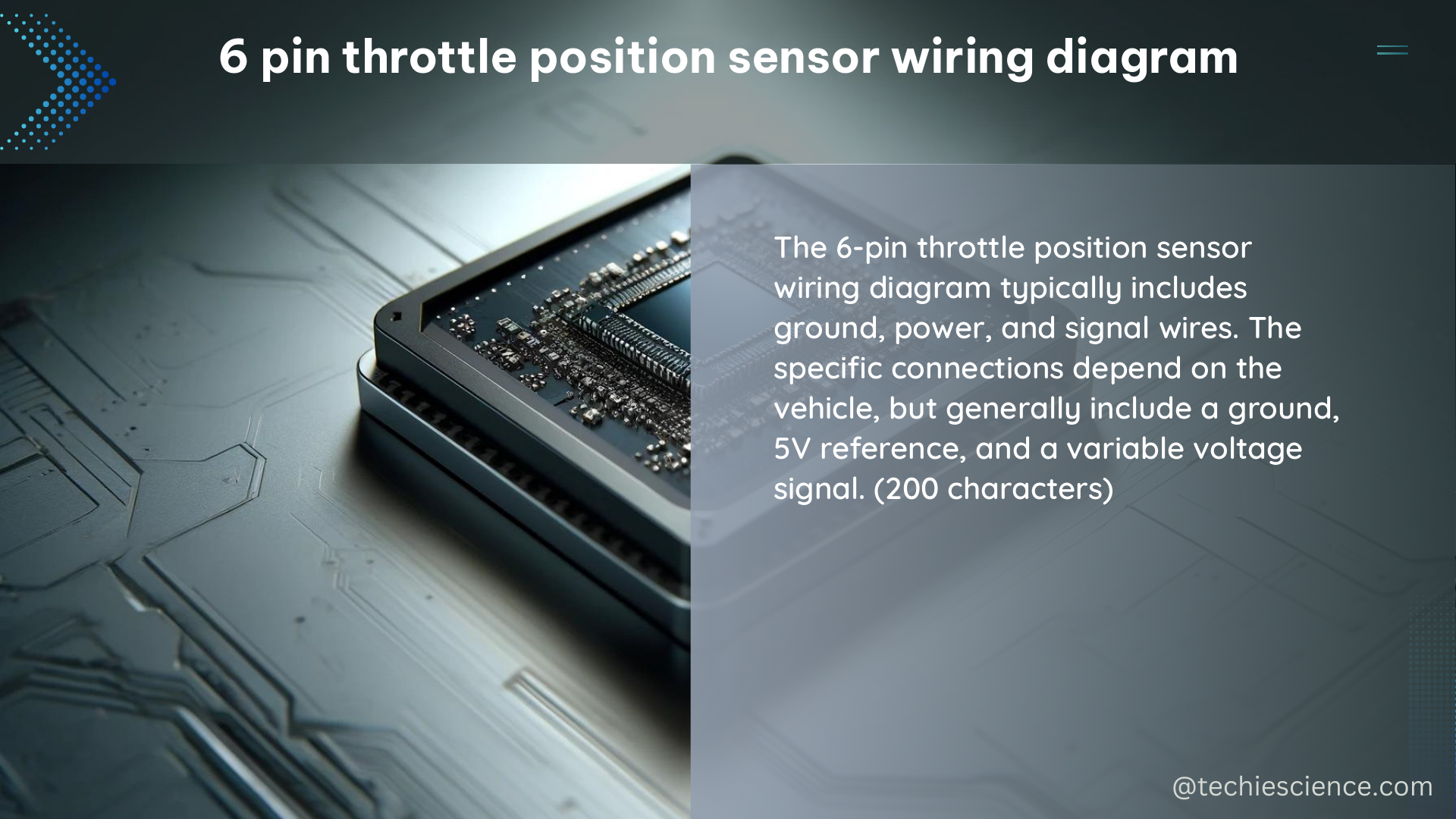The 6-pin throttle position sensor (TPS) is a critical component in modern vehicle engines, providing essential information about the throttle position to the engine control unit (ECU). This sensor converts the throttle position into an electrical signal, which the ECU then uses to control various engine functions, such as fuel injection and ignition timing.
Understanding the 6-Pin TPS Wiring Diagram
The 6-pin TPS wiring diagram typically includes the following pins:
- Power Supply (Vcc): This pin provides the sensor with the necessary 5-volt power supply, which is the standard voltage used for most TPS sensors.
- Ground (GND): This pin provides the sensor with a ground connection, ensuring a stable and reliable electrical circuit.
- Signal Output (SIG): This pin outputs the sensor’s signal, which varies in voltage from 0.5 to 4.5 volts, depending on the throttle position. The ECU uses this signal to determine the throttle position.
- Reference Voltage (REF): This pin provides a stable reference voltage for the sensor, typically around 5 volts, which helps the ECU accurately interpret the signal output.
- CAN-bus (CAN): This pin is used for communication between the sensor and the ECU using the Controller Area Network (CAN) bus protocol, which is a widely used communication standard in modern vehicles.
- Idle Switch (IDL): This pin is used to detect the idle position of the throttle, which is essential for the ECU to properly manage engine idling and other related functions.
Technical Specifications of the 6-Pin TPS

The technical specifications of the 6-pin TPS wiring diagram typically include the following:
| Specification | Typical Value |
|---|---|
| Voltage | 5 volts |
| Current | 10-20 milliamps |
| Signal Output Range | 0.5 to 4.5 volts |
| Response Time | Approximately 10 milliseconds |
| Operating Temperature Range | -40 to +125 degrees Celsius |
| Operating Life | Around 100,000 miles or more |
It’s important to note that these values may vary depending on the specific make, model, and year of the vehicle, as well as the manufacturer of the TPS.
Installing and Troubleshooting the 6-Pin TPS
To install or troubleshoot a 6-pin TPS wiring diagram, follow these step-by-step DIY instructions:
- Locate the TPS: Identify the location of the TPS on the throttle body of the engine.
- Disconnect the Connector: Carefully disconnect the 6-pin connector from the TPS.
- Measure Resistance: Use a multimeter to measure the resistance between the signal output (SIG) pin and the reference voltage (REF) pin. The resistance should increase as you open the throttle.
- Check Power Supply and Ground: Measure the voltage at the power supply (Vcc) pin and the ground (GND) pin. The power supply pin should read around 5 volts, and the ground pin should be close to 0 volts.
- Verify Signal Output: Check the signal output (SIG) pin for the correct voltage range, which should increase as you open the throttle.
- Inspect CAN-bus Communication: Use a diagnostic tool to check the CAN-bus (CAN) pin for proper communication between the TPS and the ECU.
- Test the Idle Switch: Ensure the idle switch (IDL) pin registers a closed circuit when the throttle is in the idle position.
By following these steps, you can effectively install, test, and troubleshoot the 6-pin TPS wiring diagram, ensuring your vehicle’s engine is operating at its optimal performance.
Conclusion
The 6-pin throttle position sensor is a crucial component in modern vehicle engines, providing the ECU with essential information about the throttle position. Understanding the wiring diagram, technical specifications, and proper installation and troubleshooting procedures is crucial for maintaining your vehicle’s engine performance and efficiency. By following the guidelines outlined in this comprehensive guide, you can confidently tackle any 6-pin TPS-related issues and keep your vehicle running smoothly.
Reference:
- 6 Pin Throttle Position Sensor Wiring Diagram
- Throttle Position Sensor (TPS) – How it Works and How to Test it
- 6 Pin Throttle Position Sensor – Installation and Troubleshooting Guide

The lambdageeks.com Core SME Team is a group of experienced subject matter experts from diverse scientific and technical fields including Physics, Chemistry, Technology,Electronics & Electrical Engineering, Automotive, Mechanical Engineering. Our team collaborates to create high-quality, well-researched articles on a wide range of science and technology topics for the lambdageeks.com website.
All Our Senior SME are having more than 7 Years of experience in the respective fields . They are either Working Industry Professionals or assocaited With different Universities. Refer Our Authors Page to get to know About our Core SMEs.